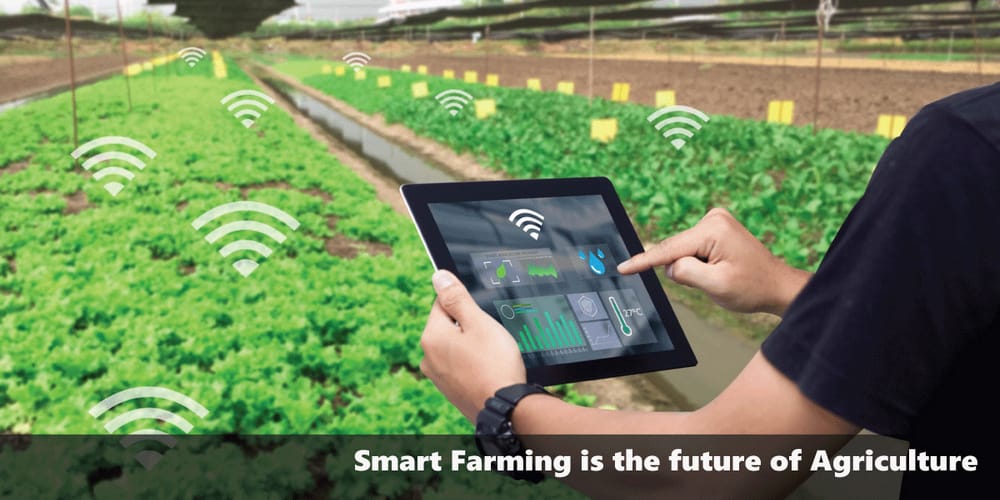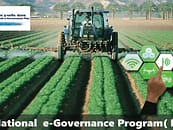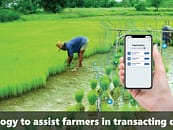What is Smart Farming?
Smart farming is the new age farming technique which utilizes information and data technologies for bringing innovation transformation in the conventional farming systems. It encompasses not just farm machineries but also farm operations. Farmers and other stakeholders use mobile devices like smartphones and tablets to access real-time data about the condition of soil and plants, terrain, climate, weather, resource usage, manpower, funding, etc. This easy availability of data enables farmers and other stakeholders to make informed and timely decisions that can save them from potential losses.
Agriculture 4.0 introduces Smart Farming to us
Agriculture 4.0 heralds the digitization of agriculture and food supply chain using Artificial Intelligence (AI), Internet of Things (IoT), Process Automation and other technologies to create a hyper-connected network of farm lands, machinery and processing units that result in optimization of both food production and consumption. These systems are getting utilized for tracking, monitoring, automating and analysing operations under architecture Agriculture 4.0. Smart farming being an integral part of this digital era of agriculture relies on sensor monitoring and software analysis of data obtained from the sensors.
Modern farms and agricultural operations will work on technological superior platforms that include an amalgamation of sensors, devices, machines, and information technology. Smart Farming techniques will use sophisticated technologies such as robots, temperature, soil health and moisture sensors, aerial images, and GPS/ GNSS technology, to list a few.
These advances in technology will make farming business more profitable, efficient, and ecological friendly. Agriculture 4.0, the envisaged agricultural revolution, must be environmentally sustainable, with science and technology at its core. Agriculture 4.0 will need to balance both the demand side and the supply side of the food-scarcity equation, using technology as an enabler to improve and address the real needs of farmers, consumers and transform the entire value chain.
Few examples of Smart Farming
To give some context to Smart Farming, Instruments with sensors embedded are used for scanning soil, reporting for the moisture content, chemical compositions and other useful information that is transmitted to farmer’s mobile devices. Based on the analytical modelling, the farmer decides the amount of water or fertiliser to be supplied to the field. This process not only saves manual labour but also saves some cost of input as only the requisite quantity of supplements is fed to the field.
Apart from sensors, telecommunication technologies like advanced networking and Global Positioning System (GPS) are also utilised for applications like soil sampling, tractor guidance, crop scouting and yield mapping. Satellite imaging and drones are other crucial technologies that have made remote monitoring of fields more accurate.
Smart farming techniques have not just optimised irrigation and fertilising but also help in pest control. The drone imaging of difficult to access parts of the fields help in detecting pests and weeds at early stages. Targeted spray of pesticides and weedicides can also be carried out by the drones. These techniques are also empowering the allied sectors like animal husbandry, dairying and fisheries by monitoring the cattle health and nutrition levels.
Technological interventions under smart farming have also improved the efficiency of agricultural insurance and banking. With more reliable and easily accessible data on yield and weather conditions etc. the claims settlement process has been smoother.
Focus Agritech’s Outlook
Introduction of Information and communication Technology in agriculture has manifold benefits. With significant cost savings at multiple levels of harvest, farmers would have better margins. There are proven results of improved process efficiency and output which translates into better revenues for all stakeholders. It’s high time to scale these technologies to catalyse the mission of Doubling farmers’ income by 2024
Traditional farm equipment companies have started to integrate smart farming tools in their offerings. John Deere has connected its tractors to the Internet and has created a method to display data about farmers’ crop yields. Agriculture 4.0 has begun and it’s an era of opportunity for companies to come up with technologies to make smart farming smarter.
Recent Article
Aquaponics is revolutionising Organic Farming Sustainability







